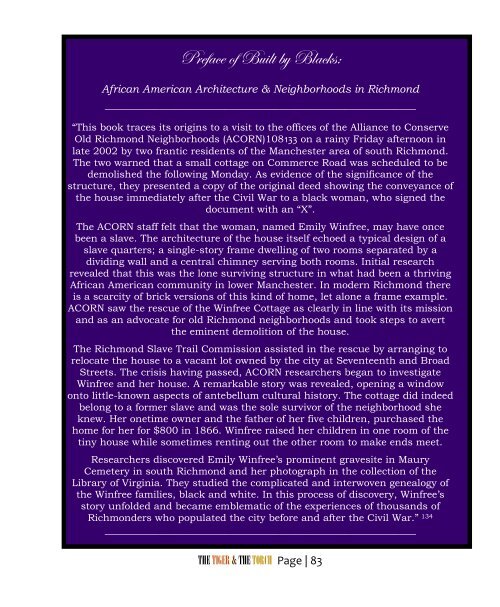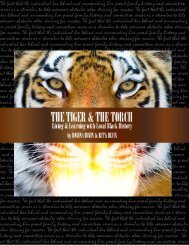You also want an ePaper? Increase the reach of your titles
YUMPU automatically turns print PDFs into web optimized ePapers that Google loves.
Preface of Built by Blacks:<br />
African American Architecture & Neighborhoods in Richmond<br />
_________________________________________________________<br />
“This book traces its origins to a visit to the offices of the Alliance to Conserve<br />
Old Richmond Neighborhoods (ACORN)108133 on a rainy Friday afternoon in<br />
late 2002 by two frantic residents of the Manchester area of south Richmond.<br />
The two warned that a small cottage on Commerce Road was scheduled to be<br />
demolished the following Monday. As evidence of the significance of the<br />
structure, they presented a copy of the original deed showing the conveyance of<br />
the house immediately after the Civil War to a black woman, who signed the<br />
document with an “X”.<br />
The ACORN staff felt that the woman, named Emily Winfree, may have once<br />
been a slave. The architecture of the house itself echoed a typical design of a<br />
slave quarters; a single-story frame dwelling of two rooms separated by a<br />
dividing wall and a central chimney serving both rooms. Initial research<br />
revealed that this was the lone surviving structure in what had been a thriving<br />
African American community in lower Manchester. In modern Richmond there<br />
is a scarcity of brick versions of this kind of home, let alone a frame example.<br />
ACORN saw the rescue of the Winfree Cottage as clearly in line with its mission<br />
and as an advocate for old Richmond neighborhoods and took steps to avert<br />
the eminent demolition of the house.<br />
The Richmond Slave Trail Commission assisted in the rescue by arranging to<br />
relocate the house to a vacant lot owned by the city at Seventeenth and Broad<br />
Streets. The crisis having passed, ACORN researchers began to investigate<br />
Winfree and her house. A remarkable story was revealed, opening a window<br />
onto little-known aspects of antebellum cultural history. The cottage did indeed<br />
belong to a former slave and was the sole survivor of the neighborhood she<br />
knew. Her onetime owner and the father of her five children, purchased the<br />
home for her for $800 in 1866. Winfree raised her children in one room of the<br />
tiny house while sometimes renting out the other room to make ends meet.<br />
Researchers discovered Emily Winfree’s prominent gravesite in Maury<br />
Cemetery in south Richmond and her photograph in the collection of the<br />
Library of Virginia. They studied the complicated and interwoven genealogy of<br />
the Winfree families, black and white. In this process of discovery, Winfree’s<br />
story unfolded and became emblematic of the experiences of thousands of<br />
Richmonders who populated the city before and after the Civil War.” 134<br />
_________________________________________________________<br />
<strong>THE</strong> <strong>TIGER</strong> & <strong>THE</strong> <strong>TORCH</strong> Page | 83



